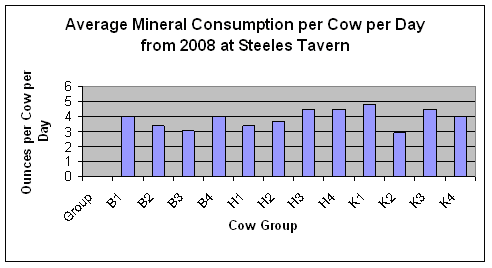
You've reached the Virginia Cooperative Extension Newsletter Archive. These files cover more than ten years of newsletters posted on our old website (through April/May 2009), and are provided for historical purposes only. As such, they may contain out-of-date references and broken links.
To see our latest newsletters and current information, visit our website at http://www.ext.vt.edu/news/.
Newsletter Archive index: http://sites.ext.vt.edu/newsletter-archive/

You Can Cut Corners on Cow Minerals, Just Not Right Now
Livestock Update, March 2009
Dr. Mark L Wahlberg, Extension Animal Scientist, VA Tech
![]()
Cows calving during January through March are right now experiencing their highest nutrient demand for the year. This comes at a time when the quality of feed they are offered is often less than the best. This mismatch between feed quality and cow nutrient requirements can have serious implications later.
The economic situation has put cow-calf producers in a cost-price squeeze. Costs of a lot of inputs are higher than they have been historically (except for the ridiculous levels seen last spring-summer). Calf prices, on the other hand are lower. This means that producers must find some ways to cut corners to reduce cost, but not reduce production - especially RE-production.
Below are values for a 1250 pound mature cow in good body condition. The first 2 rows of information relate to her stage of production. The top row indicates how many days have passed by since she was bred, thus how far along she is in pregnancy. The second row indicates days post-partum, or how many days have passed since she calved. The important items in the table are the daily amount of 3 important minerals required by this cow in the various stages of production.
Table 1. Daily Mineral Requirement (milligrams) for a Mature Cow in
Various Stages of Production Throughout the Year.
| Days Pregnant | 0 | 0 | 40 | 120 | 240 |
| Days Post Partum | 30 | 90 | 120 | 200 | 0 |
| Ca, mg | 45 | 45 | 42 | 32 | 37 |
| Phos, mg | 28 | 28 | 26 | 20 | 21 |
| Mg, mg | 26 | 26 | 16 | 15 | 15 |
| Calve Feb | March | May | June | Sept | Jan |
| Calve Oct | Nov | Jan | Feb | May | Sept |
Values calculated using the "Beef NRC" computer software available from National Research Council (NRC) |
|||||
As shown in the table, cows have their highest requirements for minerals from calving to breeding. This is depicted in the first 2 columns, when the cow is either 30 or 90 days post partum. You will note that the required amount of Calcium, Phosphorous, and Magnesium are at their highest levels during this phase. When a cow progresses into early pregnancy, she is nursing a calf that is several months of age. Because her milk production has begun to decline, her mineral requirements also decline. By the time her calf gets to be around 7 months old, typical of weaning age for many producers, her mineral requirements have fallen to around the lowest level of the year. They pick up again as she moves into late pregnancy (depicted by 240 days of pregnancy), but only slightly higher than at weaning.
You will note that a cow calving in February experiences those elevated requirements at a time when pasture is not available. This high requirement for minerals continues until she is rebred. A properly formulated complete cow mineral will have 10 to 16% Calcium and anywhere from 2 to 6% Phosphorous. A high Magnesium mineral will have from 10 to 14% Magnesium. Cows that are in the phase of production between calving and re-breeding need to receive such a complete mineral. Cutting corners on the mineral fed at this time could lead to reduced milk production, metabolic imbalances, and grass tetany. Reduced fertility and impaired calf growth may result. In addition, cows can die from some of these imbalances and deficiencies.
Many microminerals are also important in the complete mineral. Adequate levels of Zinc, Copper, Selenium, and other individual items are important. A properly formulated commercial cow mineral should have adequate amounts of these important items.
The Shenandoah Valley Agricultural Research and Extension Center (SVAREC) at Steeles Tavern is the home for Virginia Tech's commercial cow-calf research program. Detailed records on all inputs are kept, including minerals. The research herd is divided into 12 different groups, and each is a separate management group. During 2008 the average mineral intake for each group per cow ranged from 2.9 to 4.5 ounces per cow per day. Notice that these are clustered around the 4 ounce per head per day level. This documents that cow mineral intake is about what it is supposed to be when a good formulation is fed properly.

I know that minerals cost money. At 4 ounces per head per day, the yearly intake of mineral is 90 pounds. If minerals cost $15 per 50-pound bag, the yearly mineral supplementation cost per cow is $27. This may seem like a big item relative to the income from sale of a calf. However, it is an essential part of the nutrition/health complex that results in cows getting bred, calving on time, and raising healthy calves.
Once a cow is rebred you may be able to cut some corners. For example, the Magnesium level could be reduced. So could the Phosphorous level. But don't consider making any of these changes during the time from calving to rebreeding. Feed the properly formulated complete mineral that includes high levels of Magnesium from calving through end of breeding. Cow production - and RE-production are too important to try to pinch a few pennies at this critical time.